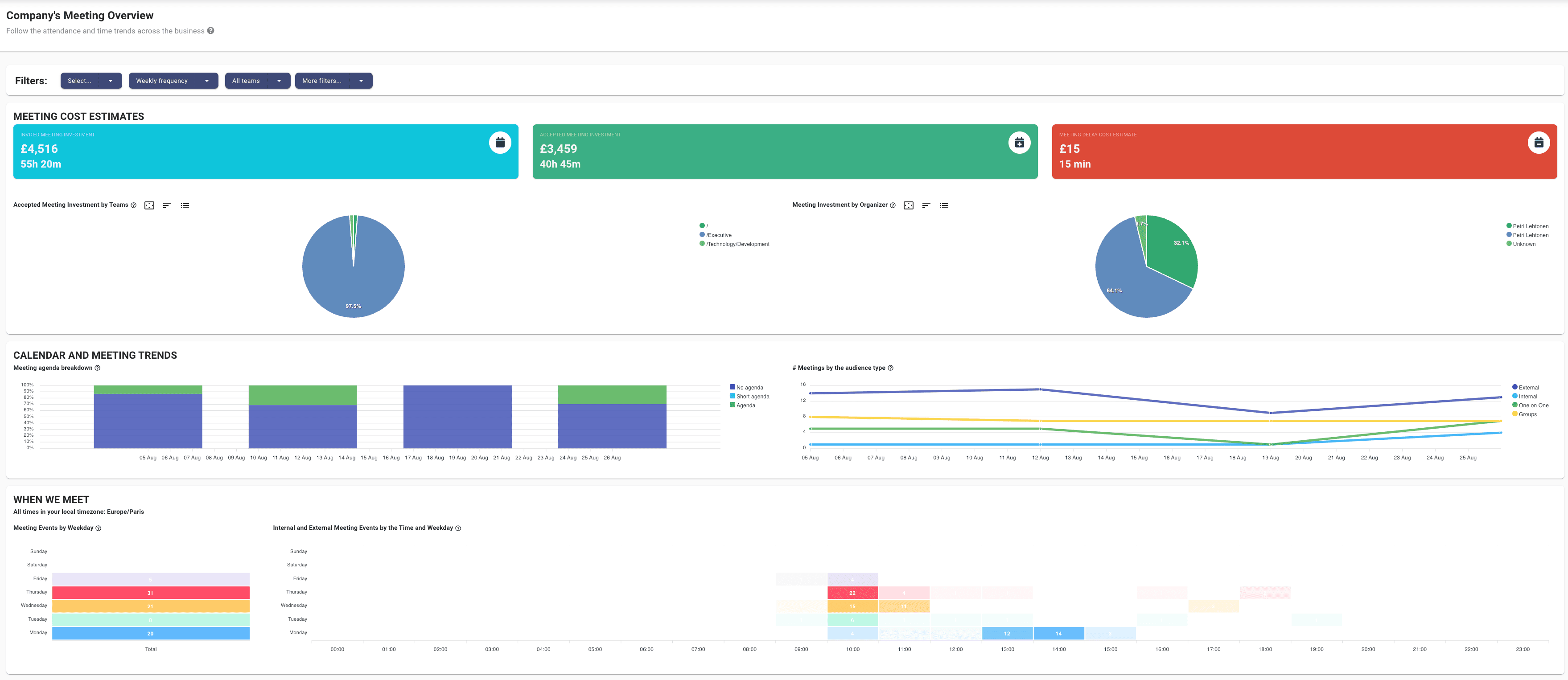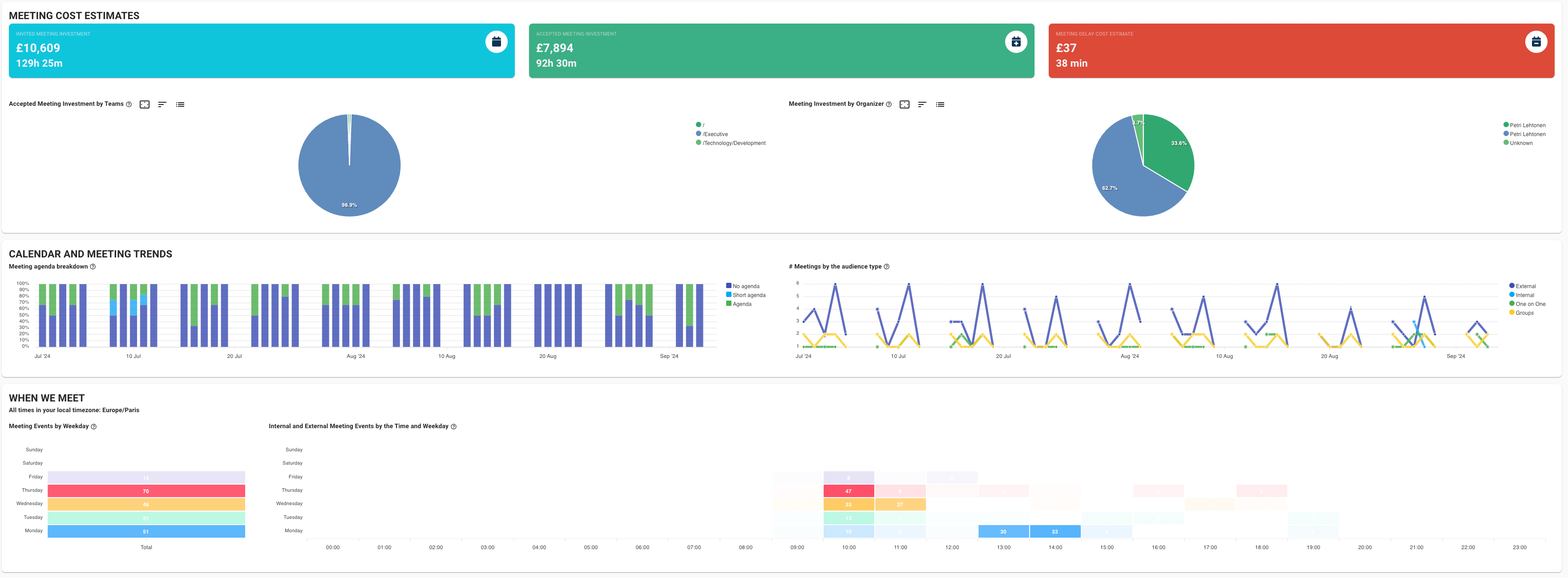Most companies think they’re managing meetings. They add agendas, assign facilitators, reduce default durations. And while these are all good practices, they often create the illusion of control, fixing symptoms without addressing the system.
The real issues with meetings aren’t inside any single calendar invite. They’re structural. Too many meetings. Too many attendees. Recurring calls that never get reviewed. Agendas that no one follows. Time that disappears with no accountability or feedback loop.
These problems don’t get solved by tweaking one meeting at a time. They require a higher-level approach.
True meeting management means managing how your organization meets as a whole, not just managing individual meetings.
This article introduces a more strategic way to think about meeting management: one that’s data-informed, systems-driven, and built for real behavioral change. We'll explore what’s broken, what high-level meeting management looks like, and how you can shift from reactive fixes to sustainable improvement.

A Shift From Reactive to Systemic Meeting Management
For years, meeting management has been synonymous with managing logistics. Tools have focused on helping you run a single meeting better, such as agendas, timers, shared notes, transcription bots, and collaborative docs. And while helpful, this approach treats symptoms, not causes.
What’s missing is a system-wide view. Most companies have no idea how much time is being spent in meetings across departments, how often agendas are used, or how much those meetings are actually costing in salary terms. They’re optimizing the experience inside individual meetings without understanding the impact meetings are having at scale.

Real meeting management is about managing the system, not just the schedule. It means having visibility across the entire organization, setting policies that support deep work and clear outcomes, and nudging behavior toward intentional time use.
This matters more than ever. According to Microsoft’s 2023 Work Trend Index, the average employee spends 25% of their week in meetings, and 68% say they don’t have enough uninterrupted focus time to get meaningful work done.
The conclusion is clear: If meetings are eating into your most valuable resource, time, you need more than tactical fixes. You need to manage meetings like a system, not a series of events.
The Challenges of Modern Meeting Culture
Most organizations don’t suffer from a lack of meeting tools, they suffer from a lack of meeting systems. Without a structured approach, meetings become reactive, redundant, and resource-draining. Here are four persistent challenges that undermine meeting effectiveness at scale:
Meeting Sprawl
Meetings tend to multiply. One check-in becomes a weekly recurring call. A planning session spawns multiple follow-ups. Over time, calendars fill with overlapping invites, many lacking clear purpose or outcomes.
A study by the London School of Economics found that 35% of business meetings are considered unproductive, costing U.S. firms an estimated $259 billion annually.
Meeting overload is a well-documented and costly trend, and one that organizations must proactively address.
Calendar Chaos
Without centralized visibility, it’s nearly impossible to understand how meeting time is distributed across teams and roles. Some departments are overloaded, while others are underutilized. The result is an uneven landscape where time is misallocated and priorities are misaligned.

You need to analyze calendar data to identify patterns and optimize meeting schedules across the company.
Meeting Inequity
Certain roles or individuals often bear the brunt of meeting overload, while others are left out of critical conversations. This imbalance can lead to disengagement, reduced productivity, and a lack of diverse perspectives in decision-making processes.
Companies working on improving leadership meeting time and equitable collaboration often uncover biases that affect decision quality.
Lack of Accountability
In many organizations, there’s no feedback loop to assess meeting effectiveness. Meetings are scheduled, attended, and forgotten, without evaluating whether they achieved their objectives or warranted the time invested.

To close this gap, leaders must track key meeting metrics and establish a culture of continuous improvement.
Managing individual meetings doesn't solve these systemic inefficiencies. To address these challenges, organizations need to shift from a reactive approach to a proactive, system-wide strategy that emphasizes visibility, accountability, and continuous transformation.
What Meeting Management Actually Looks Like
Managing meetings effectively doesn’t mean micromanaging every calendar invite. It means treating meeting time as a strategic asset, something to be allocated, reviewed, and optimized at scale.
High-level meeting management starts by shifting how you think about meetings: from isolated events to a portfolio of time investments. Every hour spent in a meeting is time not spent on focused work, customer problems, or strategic planning. That time deserves the same scrutiny you’d give to budgets or headcount.

With the right data, you can start asking better questions:
- Where is meeting time actually going, by team, by role, by function?
- Are meetings aligning with company values, such as async-first or deep work protection?
- Who attends the most meetings, and are they essential in each one?
- Are meeting practices, like sharing agendas or starting on time, being followed?
The goal isn’t to enforce rules for the sake of it. It’s to make meeting hygiene visible and measurable so teams can self-correct. When people see patterns around calendar overload or missed agendas, it becomes easier to shift behaviors.
Over time, meeting management at this level becomes a feedback loop:
- You test changes (shorter durations, fewer attendees, async updates).
- You track what improves (meeting cost reduction, fewer overlaps, better outcomes).
- You reinforce or tweak based on real-world evidence.
This is what separates tactical fixes from actual transformation: a system that helps meetings stay useful, focused, and aligned with your operating model.
Why Traditional Meeting Management Software Falls Short
Most meeting management tools are built for the meeting in front of you. They help take notes, assign action items, and track who said what. That’s useful, up to a point. But these tools don’t solve the deeper, systemic problems that make meetings inefficient in the first place.
They’re designed for tactical execution, not strategic oversight.
They live at the meeting level, helping you run a single event better, but offering no visibility into how meetings function across the organization.
They don’t answer questions like: Are we meeting too often? Are the right people in the room? What’s the actual cost of this weekly sync?
And because they rarely integrate deeply with calendar tools or organizational data (like role, team, or cost), they can’t surface critical insights, like which departments are drowning in meetings or where most delay time is being lost.

Most importantly, these tools don't support behavior change. They don’t enforce policies, prompt better habits, or track whether those habits are improving over time.
That’s the gap: companies are trying to solve a company-wide challenge using tools built for individual moments. High-level meeting management needs more than a workspace for each meeting, it needs a system to improve all meetings.
Meeting Management That Works at the Company Level
While most meeting tools are focused on helping people run individual meetings better, Flowtrace is built to help organizations manage how they meet at scale.
It’s a system designed for leadership visibility, operational consistency, and culture-level change.
Flowtrace connects directly with your company’s Google or Outlook calendars to surface how meeting time is being spent across teams, roles, and functions. That means instead of assumptions, you get answers about volume, cost, focus, and effectiveness.
Here’s how Flowtrace enables true company-wide meeting management:
Meeting analytics: Track real data on total meeting time, attendance, punctuality, agenda usage, and even cost, broken down by department, level, or domain. See trends over time to understand if culture is improving or regressing.
Meeting policies: Set rules around meeting duration, agenda presence, and invitee limits. Flowtrace applies these meeting policies inside your existing calendar tools, flagging violations and guiding users before bad meetings happen.

Behavior nudges: Intelligent prompts help reinforce best practices in real time. Whether it’s a reminder to add an agenda, reduce attendee count, or reconsider a recurring meeting, Flowtrace supports habit change through subtle, in-context feedback.
Dashboards: Offer employees and team leads clear visibility into their meeting behavior. See where time is being spent, what’s improving, and what needs attention.
Strategic oversight: Give leadership the data to guide transformation. Understand which teams are overloaded, which habits are spreading, and where intervention might be needed.
With Flowtrace, you don’t just collect meeting data, you build a structure that turns it into better decisions and habits. You don’t need another tool to run a better meeting. You need a system that manages meetings across the company.
Start Managing Meetings Like You Mean It
It’s easy to treat meeting problems as calendar issues: reschedule here, shorten that, nudge someone to share an agenda. But those are surface-level fixes.
Meeting management isn’t about adjusting schedules, it’s about building systems.
The cost of not addressing this holistically is real: lost focus, decision delays, disengaged teams, and thousands of hours tied up in meetings with no clear value.
If you’re still managing meetings one invite at a time, you’re missing the bigger picture.
The opportunity is to shift your organization’s perspective, from fixing broken meetings to redesigning how you meet. That starts with visibility. Then structure. Then consistency.
You need more than a better invite. You need a better system.
